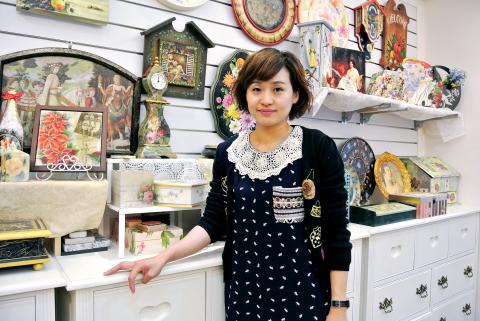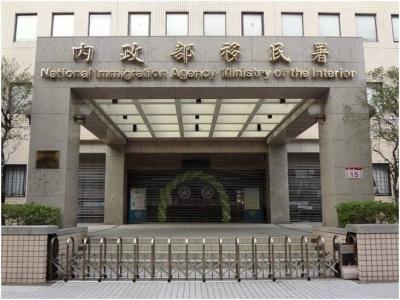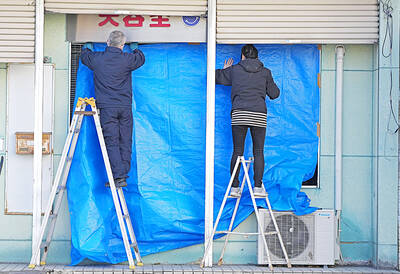“Household items can become works of art,” home decor artist Huang Ssu-wei (黃思維) said as she used decoupage techniques to cover notebooks, chairs and tables with cutouts of decorative napkins and colored wrapping paper, turning old items into works of art.
The term decoupage refers to the technique of decorating an object by gluing colored paper, gold leaf and other materials to it, in combination with special paint effects.
Using this technique, a small box or an item of furniture is covered with cutouts from magazines or from purpose-manufactured papers. Each layer is then sealed with varnish, and sanded to a polished finish to conceal the “stuck on” appearance, with the results looking like paint or inlay work.

Photo: CNA
According to Huang, decoupage was very fashionable in Europe during the 17th and 18th centuries. The interiors of royal and aristocratic homes often featured beautifully designed and exquisitely decorated furniture. Because the general public could not afford these items, they cut out designs and patterns from printed materials and glued these onto their furniture, she said, adding that arising from common folk culture, this handicraft art technique evolved into what was later called decoupage.
She said decoupage is still popular in Italy, where there are professional schools and companies working on the research and design of specialty decoupage papers.
Annual decoupage exhibitions are still being held in Italy, she added.
Huang said she was traveling in the Czech Republic some years ago, when she discovered some decoupage decoration in a furniture shop that made a deep impression on her.
After returning to Taiwan, she looked for teachers to teach her the technique.
Committed to mastering the craft, she quit her office job and focused all her efforts on setting up a decoupage studio.
She is now teaching the handicraft to students in Greater Tai-chung after she obtained a teaching certificate from the Italian Decoupage firm TO.DO Hobby & Craft Division of Colorificio Centrale S.p.A.
Using the decoupage technique, Huang says she is able to convert old into new.
She said even an old refrigerator can be made to look like new, and she can even compose cutouts to look like a painting.
“During the Lunar New Year holidays, I always feel sad to see many pieces of furniture discarded by the side of the road. Actually, all it takes is a little creative thinking and the application of your ideas. Furniture can be renovated to look like new. This can save money because you do not need to buy new stuff. Furniture adorned with decoupage can become works of art, which decorate spaces in your home,” she said.
According to Huang, the most simple decoupage technique is to cut out a pattern or pictures from napkins, cotton paper or colored wrapping paper, then apply an adhesive coating to the item, affix the cutouts onto it, and after that apply a further layer of adhesive coating.
“Decoupage is really simple to learn. It’s not like painting, which requires a lot of skill and practice. If you know how to cut, paste and affix things, you can complete the task,” she said.
“Even if you make some mistakes, these can be rectified. For impatient people, decoupage is easy to get into. You can start on something and have the product finished in no time,” she added.
After teaching decoupage techniques for about 10 years, Huang said her sense of satisfaction comes from her students’ finished products, “especially when they turn ordinary everyday objects into works of art, that is when I feel most proud.”

A small number of Taiwanese this year lost their citizenship rights after traveling in China and obtaining a one-time Chinese passport to cross the border into Russia, a source said today. The people signed up through Chinese travel agencies for tours of neighboring Russia with companies claiming they could obtain Russian visas and fast-track border clearance, the source said on condition of anonymity. The travelers were actually issued one-time-use Chinese passports, they said. Taiwanese are prohibited from holding a Chinese passport or household registration. If found to have a Chinese ID, they may lose their resident status under Article 9-1

Taiwanese were praised for their composure after a video filmed by Taiwanese tourists capturing the moment a magnitude 7.5 earthquake struck Japan’s Aomori Prefecture went viral on social media. The video shows a hotel room shaking violently amid Monday’s quake, with objects falling to the ground. Two Taiwanese began filming with their mobile phones, while two others held the sides of a TV to prevent it from falling. When the shaking stopped, the pair calmly took down the TV and laid it flat on a tatami mat, the video shows. The video also captured the group talking about the safety of their companions bathing

PROBLEMATIC APP: Citing more than 1,000 fraud cases, the government is taking the app down for a year, but opposition voices are calling it censorship Chinese Nationalist Party (KMT) Chairwoman Cheng Li-wun (鄭麗文) yesterday decried a government plan to suspend access to Chinese social media platform Xiaohongshu (小紅書) for one year as censorship, while the Presidential Office backed the plan. The Ministry of the Interior on Thursday cited security risks and accusations that the Instagram-like app, known as Rednote in English, had figured in more than 1,700 fraud cases since last year. The company, which has about 3 million users in Taiwan, has not yet responded to requests for comment. “Many people online are already asking ‘How to climb over the firewall to access Xiaohongshu,’” Cheng posted on

A classified Pentagon-produced, multiyear assessment — the Overmatch brief — highlighted unreported Chinese capabilities to destroy US military assets and identified US supply chain choke points, painting a disturbing picture of waning US military might, a New York Times editorial published on Monday said. US Secretary of Defense Pete Hegseth’s comments in November last year that “we lose every time” in Pentagon-conducted war games pitting the US against China further highlighted the uncertainty about the US’ capability to intervene in the event of a Chinese invasion of Taiwan. “It shows the Pentagon’s overreliance on expensive, vulnerable weapons as adversaries field cheap, technologically